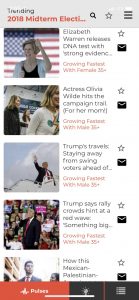
Social Media At 11 (And Other Newscasts)

“Social media has come a long way in the last 10 years,” says Jeff Anastasio, director of digital content for Tegna’s WFAA Dallas. “It’s revolutionized our industry.
“Thank goodness we have that opportunity to understand the audience. They’re our neighbors, our teachers, our police officers. We are not flying blind in trying to understand the issues that are important.”
And to make the most of it, TV stations are arming themselves with software that allows them to slice and dice social media to gauge audience interest in stories, share viewer feedback and even predict what stories will become larger issues in the future. Other software speeds the integration of social media into newscasts.
Take, for instance, CrowdTangle. It aggregates content from platforms like Facebook, Instagram, and Twitter and determines which posts are garnering the most audience engagement, says Anatasio.
At the direction of the user, CrowdTangle can focus on social media involving local topics or institutions like the police or schools, or it can follow content of national relevance, he says.
“We’re taking a broader approach. It’s less about the back and forth talking points that you expect to get, and more about what real people are feeling and talking about in their communities. We pull out the important discussions and pull those into our political coverage.”
Megaphone TV is an instant polling tool. Anchors can use it to pose a question and invite the audience to respond via smartphone. The results display in real time.
“We’ve had a lot of success tying that into what’s happening on television,” Anastasio says. “People are quick to want to grab their phone and jump in. They want to voice their opinions.”
WFAA used Megaphone during the Texas Senate race debates earlier this month to gauge public response to the Ted Cruz-Beto O’Rourke debate.
Tegna is especially interested in tools that can help it cover political races. The group is following gubernatorial races in 19 markets and senatorial races in 16.
“These elections are a very big deal for Tegna,” says Adam Ostrow, Tegna’s chief digital officer. “As far as social is concerned, we’ve been doing a lot in the leadup to the elections. It’s something we’re all in on as an organization.”
Tegna also uses Tagboard as a link between social media and broadcast. It uses hashtags to search for and collect posts within seconds of their being posted and then integrates them into broadcasts. “We’ll do more of this in the lead-up to the election and on election day,” he adds,
Another tool for tracking Facebook, Instagram and Twitter is Social News Desk.
Derek Drake, client success manager at Social News Desk, says the customizable SND dashboard helps journalists gather news from “a ton of different sources” and is “designed to organize the workflow of how the user wants to operate.”
The SND dashboard can be used to monitor analytics, curate content, create contents and manage accounts. A related offering from the company — SND On Air — can take social content from the dashboard and run it on air via a scan converter.
“Depending on what you use social for, you can pretty much do it in the dashboard,” Drake says. “Because it’s web-based, if you know how to post to Facebook or Twitter, then you pretty much know how to post with our tools.”
This is important because social media tends to be an afterthought for the on-air talent, he says.
While there are many social media monitoring tools on the market, Drake says SND stands apart. “We do it from a journalistic standpoint, from understanding newsrooms, rather than catering to brands.”
SND ought to understand newsrooms. It’s owned by Graham Media, which operates stations in seven markets, including three in the top 20.
Shout is an offering from ChyronHego. It lets producers monitor, select and route social media conversations directly to template-based broadcast graphics systems for on-air playback.
“We’ve been increasingly taking an agnostic approach to the aggregation component,” says Drew Hahn, ChyronHego’s director of product management, graphics and workflow.
While ChyronHego has its own tools that aggregate social media content, the company also works with third-parties who are becoming “more specialized with cutting through the clutter” of the social media data stream, says Hahn.
Accoring to Hahn, ChyronHego’s workflow tools let broadcasters create an animated or still image using the same producer tools and graphics package they do for the rest of their news.
“For example, they might declare the winner of a contentious race by creating an image that says ‘Smith beats Jones’ using a template from their insert graphics package,” he says.
“From a branding perspective, this is very powerful as your audience is not just sharing your post, but the visual aspects of your identity. They are literally passing around a frame of your newscast, which is so much better than simple text. Best of all, this happens within a familiar tool to the producer. Nothing new to learn.”
On election night, one of the biggest uses of social media is finding quotes from politicians or political leaders. The station’s workflow needs to be able to quickly import such quotes and prep them for broadcast with a look compatible with the rest of the station’s graphics.
“Shout has an approval layer that some news organizations use to allow an executive producer to authorize a post before the graphic becomes available,” Hahn says. “But once it is available, a producer can insert it into their story using LUCI, [ChyronHego’s news graphics workflow tool] with their newsroom system as they would any other fullscreen graphic.”
Another social media monitoring tool aims to help news personnel find the best angle for covering a particular issue or candidate.

Futuri’s TopicPulse mobile app shows social media trends for midterms.
Futuri’s TopicPulse tracks what’s trending on Facebook, Twitter, Instagram and other social networks and helps reveal sentiment about specific topics. Such information can also be used to identify experts for newscasts and to determine when stories should run, says Futuri CEO Daniel Anstandig.
According to Anstandig, the TopicPulse technology was developed in 2011 because broadcasters were complaining that on-air content lagged behind what was being posted on social.
A study monitoring multiple markets followed, assessing when social trends started, when they peaked and when broadcast coverage occurred. There were significant time gaps of up to 12 hours between something posting on social and something running on air. The study also revealed that interest in the basic facts of a story lasts only a short time, while the hows and whys can hold audiences for a long time.
“In a newsroom today, there’s a mix between art and science. We think of ourselves as the science part,” Anstandig says. “Real-time insights matched with skillful production of news, that’s magic.”
TopicPulse scans more than 100,000 news sources, including social media outlets, and tracks the demographics of users to gauge how many are engaging on a topic at a given time.
TopicPulse also tries to help its users look ahead. “We worked with Edison Research to create a proprietary algorithm to predict what’s going to trend,” Anstandig says. “This is what’s trending now, but is it still going to be trending at 5, 6 10, and 11?”
Anstandig adds that Futuri is continuing to invest in predictive technology and ways to integrate more data into the system.
Tegna’s Ostrow hopes future developments in the social media arena will help provide better data-driven understandings of how people feel about issues.
“One thing that has not been perfect is sentiment analysis,” he says. “Understanding social sentiment is super interesting. In the meantime, we’re looking at it in a more qualitative way.
“All of our reporters and digital producers are highly engaged in social media, interacting with the audience, reflecting their concerns in our reporting. Several years out, perhaps by 2020, I’ll be interested to see how, through data, we can better understand some of those things in a more quantitative way.”
Anastasio echoes the desire to better understand sentiment. But even more than that, he looks forward to the day broadcasters can easily bring off-site individuals right into broadcast coverage.
Getting comments via tweets is interesting, but “sometimes you miss the energy and passion behind the person’s voice,” he said. “What does Bob in Frisco think about this decision? Push a button, talk to him. That would be pretty cool.”
































Comments (0)